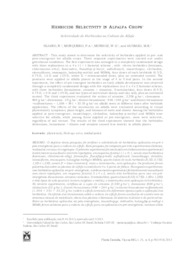Herbicide selectivity in alfalfa crops.
Herbicide selectivity in alfalfa crops.
Autoria: HIJANO, N.; MONQUERO, P. A.; MUNHOZ, W. S.; GUSMAO, M. R.
Resumo: This study aimed to determine the selectivity of herbicides applied in pre- and post-emergence for alfalfa crops. Three separate experiments were carried out under greenhouse conditions. The first experiment was arranged in a completely randomized design with three replications in a 4 x 11 + 1 factorial scheme , with eleven herbicides (bentazon, chlorimuron-ethyl, fomesafen, fluazifop-p-butyl, saflufenacil, imazethapyr, clethodim, nicosulfuron, imazaquin, haloxyfop-methyl and MSMA), four doses of each herbicide (0.5 D, 0.75 D, 1.0 D and 1.25 D, where D = recommended dose), plus an untreated control. The products were applied to alfalfa plants at the stage of 4 to 5 leaf pairs. In the second experiment, the effect of pre-emergent herbicides on early alfalfa development was observed through a completely randomized design with five replications in a 3 x 4 x 2 factorial scheme, with three herbicides (hexazinone, atrazine + simazine, S-metolachlor), four doses (0.5 D, 0.75 D, 1.0 D and 1.25 D), and two types of soil texture (loamy and clay soil), plus an untreated control. The third experiment evaluated the action of atrazine, 2,550 g ha-1; clomazone - 600 g ha-1; diclosulam - 25 g ha-1; diuron+hexazinone - 936 + 264 g ha-1 and diuron+hexazinone +sulfometuron - 1,386 + 391 + 33.35 g ha-1 on alfalfa sown at different times after herbicide application. The effects of the treatments on alfalfa were evaluated according to visual phytotoxicity symptoms, plant height, and biomass of roots and shoots. Among the herbicides applied at post-emergence, imazethapyr, clethodim, haloxyfop-p-methyl and MSMA were selective for alfalfa, while among those applied at pre-emergence, none were selective, regardless of soil texture. The results of the third experiment showed that the herbicides diclosulam, hexazinone + diuron and atrazine caused less toxicity in alfalfa plants.
Ano de publicação: 2013
Tipo de publicação: Artigo de periódico
Unidade: Embrapa Pecuária Sudeste
Palavras-chave: Fitotoxicidade, Medicago Sativa, Período residual
Observações
1 - Por padrão são exibidas publicações dos últimos 20 anos. Para encontrar publicações mais antigas, configure o filtro ano de publicação, colocando o ano a partir do qual você deseja encontrar publicações. O filtro está na coluna da esquerda na busca acima.
2 - Para ler algumas publicações da Embrapa (apenas as que estão em formato ePub), é necessário ter, no celular ou computador, um desses softwares gratuitos. Sistemas Android: Google Play Livros; IOS: iBooks; Windows e Linux: software Calibre.
Acesse outras publicações
Acesse a Base de Dados da Pesquisa Agropecuária (BDPA) para consultar o acervo completo das bibliotecas da Embrapa.

